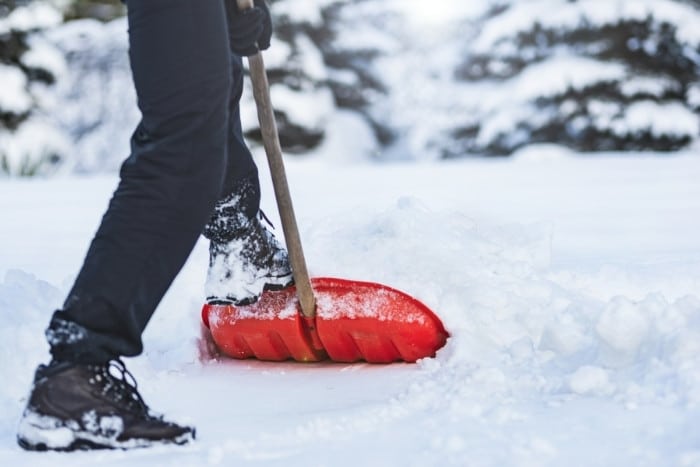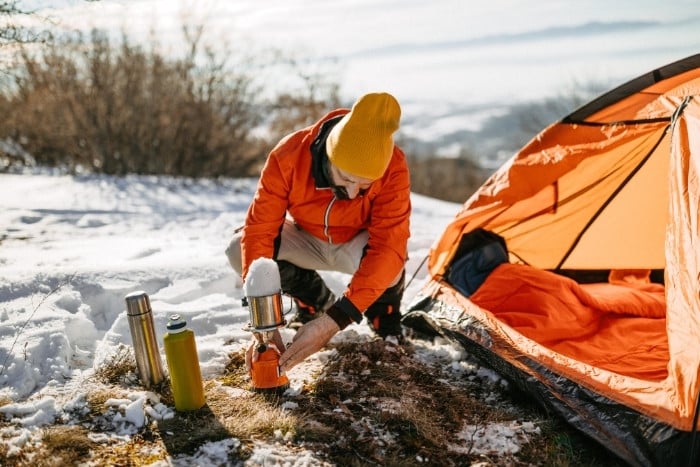Camping in snowy conditions can be an exhilarating and beautiful experience. You may yearn for snow-frosted forests and mountain peaks as your campsite backdrop but be concerned that cold conditions may become unendurable or even dangerous, with a serious risk of hypothermia. How can you survive snow camping with only a canvas between you and the freezing elements?
The key to survival in snowy conditions requires adequately preparing and bringing all necessary equipment, like a sleeping pad, non-cotton clothing, and cold-proof food. Carefully select and prep your campsite. Your campsite’s location and structure are key to staying safe, warm, and comfortable.
A successful snowy camping excursion takes preparation and sensible behavior at your campsite. Read on to discover how to get ready and camp safely before you embark on your journey.
How to Survive in the Snow on a Camping Trip? – Preparation
Packing the right equipment is essential when camping in potentially hypothermia-inducing conditions.
1. Clothes
Cold-weather clothing is an obvious and important starting point. The main aim of your gear should be to ensure that you can stay warm but not sweat too much.
Sweat can cause your body temperature to plummet when you cool down and should be avoided as much as possible. This is why the type of clothes and materials you choose are important.

Do not bring cotton.
It is not a good insulator and will soak up your sweat. Instead, choose synthetic fabrics, wool or down, as these act as better protectors against the cold.
Layers are key.
They help you regulate your body temperature as you get warmer or colder, depending on how much activity you are doing.
You may need to reduce the number of layers you wear when hiking to your campsite or setting up camp. A waterproof jacket is also important to stop you from becoming soaked if there is any fresh snowfall.
Always bring spares.
You will be much more comfortable if you can change out of wet clothing or swap soggy gloves for fresh dry ones.
Footwear.
Depending on your campsite location, you may need specialized equipment such as snowshoes or crampons to ensure you can walk properly.
Otherwise, boots that are specially insulated are a good recommendation.
2. Camping Gear
While a winter sleeping bag and a 4 season tent are an obvious necessity, especially if you are camping at a location with heavy snowfall or strong winds, other important pieces of equipment make the difference between enduring your snowy camping trip or enjoying it.
Sleeping Pads
Sleeping pads are essential for a camping trip in the snow as they create a barrier between you and the frozen surface below your tent.
Winter campers often recommend choosing a sleeping pad with an R-value of greater than 6 or doubling up on sleeping pads to maximize the protective layer below you.
In addition, a layer of insulating material under your pad is a useful tip for even further padding.
Stool and Shovel
If you have the room or capacity to bring it, a stool can be useful and keep you from losing heat from sitting on snow when you are enjoying time at your campsite or by the fire.
A shovel is also a practical tool for setting up your camping area in deep snow.

Stoves
Stoves are a vital item to pack for cooking or melting snow into water and preparing a comforting hot drink. Unfortunately, canister stoves are better for spring trips than camps in freezing conditions.
A white gas stove is a more reliable choice for your snow camps. While you won’t be able to light a canister stove below 15F, white gas stoves can burn at temperatures down to -40.
3. Food and Water
Hot drinks and soups heated on the stove are a rewarding way to spend your time at a winter camp, and a warm meal goes a long way when you’re spending a considerable amount of time in freezing conditions.
Some food is not appropriate for a cold campsite in the snow. Some energy bars may become frozen solid and inedible at lower temperatures, so bear this in mind before you pack your provisions.
When thinking about water supplies, remember that filters can often break when they freeze, so chemical purification may be a better choice for camping in the snow.
Water bottles can easily become frozen, too, so you may need to boil the water first before putting it in the appropriate container.
Surviving in the Snow at Camp
Preparation goes a long way to guarantee a safe and enjoyable experience.
However, you also need to make sensible choices about the location and set up of your campsite to ensure you stay safe, warm, and dry.
1. Campsite Location
Be conscious that you could set up your camp in an avalanche-prone area. Avoid this at all costs since this can be a deadly mistake – 27 people die annually in avalanches in the US.
Check the terrain and angle of any slopes before you choose your campsite. Although this a topic that requires thorough research before you set out, some key indicators of potential avalanche activity are:
- Cracks that shoot out as you walk or drive over them
- Sounds of air pockets getting released from snowpacks
- Paths from snow slides
- Hilly areas with no trees or a line of trees are defined and abruptly smaller.
In addition, try to find shelter from the wind, as gusts can cause temperatures in your camp to drop significantly.
Windy conditions can also lead to sleepless nights because of the noise gusty conditions can make when sleeping in a tent.
2. Camp Setup
Before you set up your tent, flatten the area where you will camp. Use snowshoes or skis to pack down the snow into a level site and then leave it to refreeze before you start assembling.
This will ensure you have a comfortable flat sleeping space and do not end up sliding to one end of your tent.
Some winter campers recommend digging a trench or hole at the opening of your tent to make exiting easier.
Similarly, shoveling out a kitchen or cooking area to provide a sheltered space for your stove can add to a snug setup at a winter site.
You could also shovel up snow to build a windbreak and use it to give your campsite extra protection from the elements.
Consider the wildlife that you may encounter in your campsite area. Although bears theoretically should be hibernating, in some areas, they do not and can be active even during the winter months.
If this is the case in the location of your site, make sure that you make your camp ‘bear-safe’ and keep food away from your tent and out of reach of potential wild scavengers.
As a final important tip, always aim to keep snow outside of your tent. Once this melts as it warms from your body heat or a heater, it can get your gear or sleeping space wet and uncomfortably cold.

Final Words
To survive a camp trip in the snow, ensure you have prepared and packed all the necessary equipment before you set out.
Once you have reached your destination, set up your camp using our snow-safe techniques to ensure you experience the full delights of a snowy camping trip.
